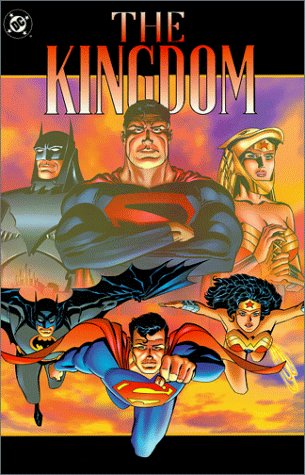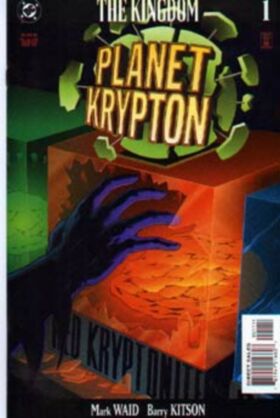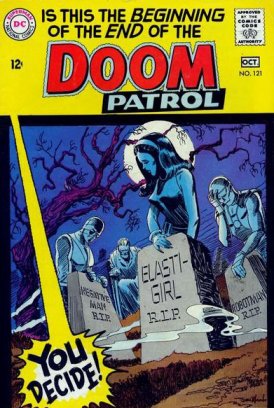Crisis
In Hypertime Zero Strikes Again:
Tracking the Continuity Shattering Events
of DC, part 3
Part 1, Part
2
note:
These articles are dedicated to frequent forum reader GreyNite1,
who loves comics but came late to the party and thus knows
very little about them. Yet we suspect that there's a lot
of GreyNites out there, so we provide this as a public service
to our readers.
|
|
|
The Big
Three ...and the Big Old Three...
|
In a "fifth-week"
event called New Year's Evil, DC focused a book on
Gog, a villain that had appeared in Kingdom Come.
The boy who would become Gog lost his family in the destruction
of Kansas, and to compensate, the mystical Quintessence
(The Phantom Stranger, Shazam, Highfather, Zeus and Ganthet)
grant him powers.
Does
Gog use those powers for good? Noooooo. If he did, we wouldn't
have The Kingdom. Instead, he kills Superman in retribution
for the destruction of Kansas, which in his mind occurred
because Superman wasn't there to stop it. Then he
goes back in time by one day and kills Superman again. And
again the day before that, and so on and so on until the
afterlife is crowded with Supermen, each a day younger than
the one before.
Naturally, this
drives the Linear Men bonkers. Gog also steals the infant
son of Superman and Wonder Woman, with the intent of raising
him to be the evil Magog.
Meanwhile, the
book starts with a side story that would have upset the
Linear Men even further had they known about it. A suspiciously
older Superman with a less-recognizable "S" symbol
pounds against an invisible barrier (later, that character
would show up in the pages of Jeph Loeb's Superman/Batman).
His struggle bookends the event, ending with a literal wink
that every Fanboy knew meant that the Superman of Earth-2
(for this is he) would one day make a return.
So reality seems
to be falling apart. In the days after the events of Kingdom
Come, the children of familiar heroes band together
to travel back in time, and thus firmly established continuity,
to prevent Gog from killing Superman in our present day
and hurrying along the destruction of Kansas.
Among those
children was the son of Bruce Wayne and Talia al'Ghul, who
had appeared in Mike W. Barr's graphic novel Son of the
Demon as a baby - a story that none other than Mark
Waid had referenced since its publication. Waid also created
Offspring, the son of Plastic Man who later appeared as
a child in JLA when Joe Kelly took over the book.
Then came Kid Flash, the daughter of Wally West, whose existence
has teased fans for years. First she was about to be born,
then she wasn't, then her mother was in continuity then
she wasn't. Oh, the fun DC editors have had.
|
|
|
Must...have...memorabilia...
|
One
of the key issues of The
Kingdom was Planet Krypton, with art by Barry Kitson, focusing
on the Metropolis-based theme restaurant owned by Booster
Gold. Ghostly alternate versions of heroes and villains
had begun haunting the place as Gog got closer to achieving
his goals. In one key panel, Batman faced a vision of Kathy
Kane, the pre-Crisis Batwoman, and for an instant dimly
remembered her.
was Planet Krypton, with art by Barry Kitson, focusing
on the Metropolis-based theme restaurant owned by Booster
Gold. Ghostly alternate versions of heroes and villains
had begun haunting the place as Gog got closer to achieving
his goals. In one key panel, Batman faced a vision of Kathy
Kane, the pre-Crisis Batwoman, and for an instant dimly
remembered her.
As a result
of possible futures clashing with our established present,
the trinity of Superman, Batman and Wonder Woman saw tomorrow,
but also saw all of the todays. A shadowy figure had lurked
at the edge of things with Matthew Ryder, a non-powered
version of Waverider from Armageddon 2001. Together
they stepped forward, revealing the unknown character to
be the adult son of Superman and Wonder Woman - maybe.
What they revealed
to the Big Three was the secret of Hypertime, something
that apparently Matthew Ryder had known about all along
and was keeping from his fellow Linear Men. All stories
happened, as realities danced alongside each other, occasionally
overlapping. Sometimes people remembered them, sometimes
they didn't; all that mattered (in a metafictional way)
was whether or not readers remembered and treasured them.
Basically, anything
that anybody wanted to count as in continuity did. Perhaps
that was too pedantic a concept; Grant Morrison and Mark
Waid were just really looking for a way for fandom to quietly
remove the continuity sticks from their fanasses and just
enjoy the stories.
Despite opening
the door to limitless possibilities, Kingdom left
Hypertime a closely guarded secret, and it's only been referenced
a couple of times since. The most notable run of Hypertime
stories occurred in Superboy, as Kon-El bounced through
a series of realities. Only appropriate, as he had also
once been recast in the role of Jack Kirby's Kamandi in
a strange effort to bring that alternate future into line
with continuity.
And so we reach
Infinite Crisis. In the years between, a few storylines
blurred the things we thought we knew. Once again, Mark
Waid was in the middle of it, with Superman: Birthright,
a twelve-issue mini-series explaining how Clark Kent assumed
the persona of Superman and just why Lex Luthor hated him
so much.
The series outraged
some fans, since it flatly contradicted things established
by John Byrne in the post-Crisis reboot, but it also tried
to reconcile the things the general public thought they
knew from movies and Smallville about how the mythos
worked.
Half-way through
the series, DC leaked word that yes, it was canon. Lex Luthor
had never been an older, portlier businessman, though he
was still a major public figure, scientific wizard and corporate
baron. He and Clark Kent had once again been boyhood friends,
and Waid even had a good explanation for how Luthor could
claim not to remember Kent.
This wasn't
getting chalked up to Hypertime.
Even more cracks
have shown up in continuity, and most of them, if not all,
by design. For at least a year, Lex Luthor had a split personality.
In Superman/Batman, Luthor went practically insane
and donned battle armor, threatening the title characters
that "…a crisis is coming." But elsewhere, Luthor remained
suave in a black business suit, never losing his cool.
Over in JSA,
the veteran heroes faced time-travelling Per Degaton, who
made cryptic remarks about characters being retconned out
of existence. Clearly, he remembered something that we previously
believed no characters other than the Psycho Pirate did.
Then when the JSA returned to the present day, they encountered
a timestorm in 1985 - the year Crisis on Infinite Earths
was published.
The multiple-origined
Power Girl, a child of Earth-2, split into multiple versions
in one panel, seeding a clue that has paid off.
By now you've
checked out the last pages of several DC books before "One
Year Later" and seen that multiple versions of each hero
appear with no explanation. Even before this happens, the
seams have begun bursting.
In Nightwing
#117, Dick Grayson references Lex Luthor's cancer, something
that happened to the fat businessman and led to the creation
of "Lex Luthor, Jr." Over in Teen Titans, Beast Boy
encounters the Doom Patrol, a group reintroduced last year
as if they had never existed, thus messing up one of Mark
Waid's retcons of the Justice League, in which the Doom
Patrol had been integral to their formation.
Beast Boy remembers
Patrol member Rita Farr as his adoptive mother, who died
saving a small fishing village. Yet he also has no idea
who she is.
DC
Editor Paul Levitz has at least fixed one little glitch
in this week's JSA, tying the bookends of Kingdom
together with our first glimpse of the Crisis exiles in
Infinite Crisis. Then he opens yet another tear with,
of all characters, the Golden Age Red Tornado, Ma Hunkel.
This
month's Superman books will also feature the Supermen living
out each other's continuity, and there's bound to be confusion
over that.
Where is it
all going? To what Mark Waid and Grant Morrison intended
with Hypertime …that maybe, just maybe, we can relax and
just enjoy the stories.
So far so good.
|








